TOYOTA YARIS 2022 Owners Manual
Manufacturer: TOYOTA, Model Year: 2022, Model line: YARIS, Model: TOYOTA YARIS 2022Pages: 590, PDF Size: 128.6 MB
Page 411 of 590
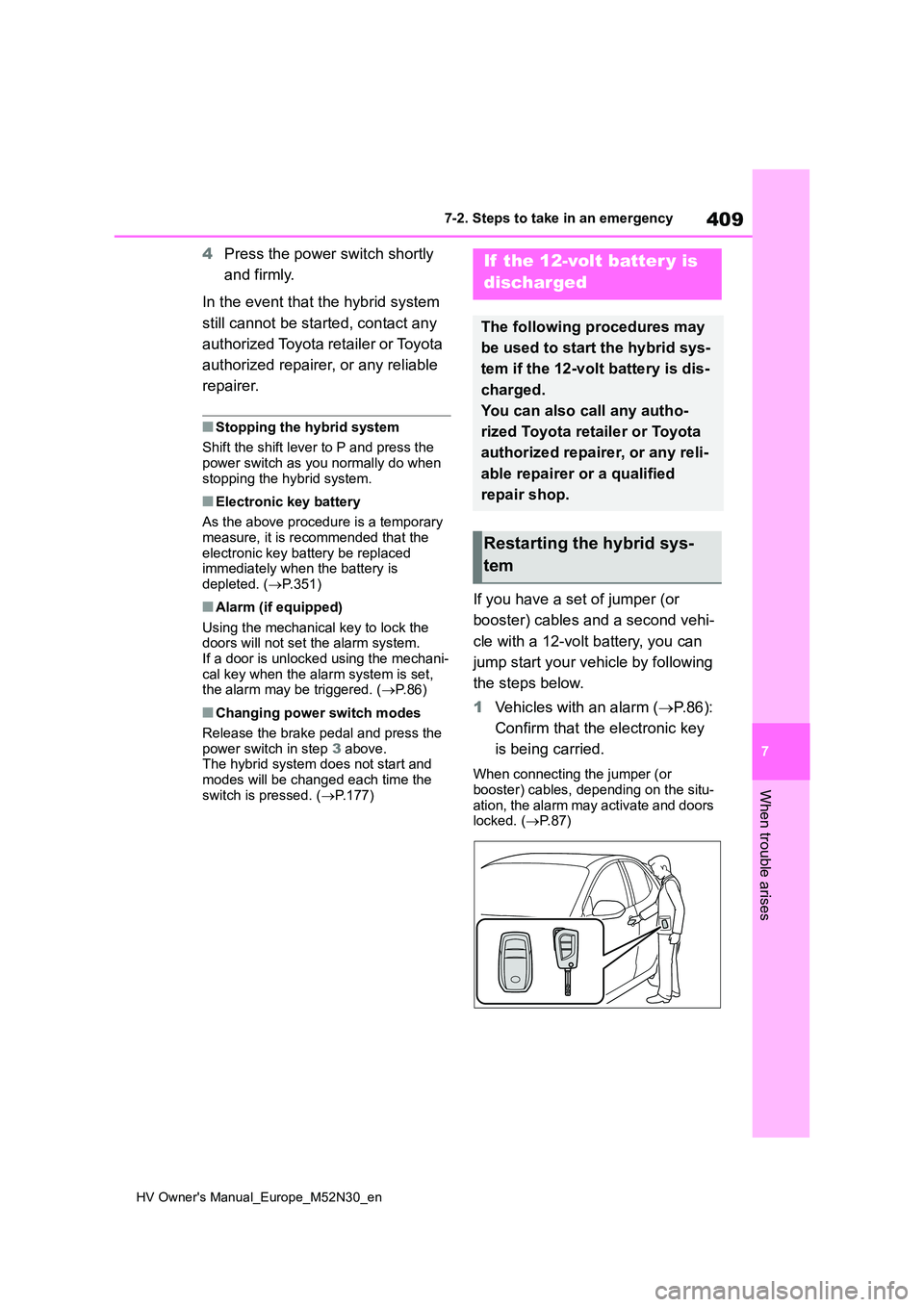
409
7
HV Owner's Manual_Europe_M52N30_en
7-2. Steps to take in an emergency
When trouble arises
4Press the power switch shortly
and firmly.
In the event that the hybrid system
still cannot be started, contact any
authorized Toyota retailer or Toyota
authorized repairer, or any reliable
repairer.
■Stopping the hybrid system
Shift the shift lever to P and press the power switch as you normally do when
stopping the hybrid system.
■Electronic key battery
As the above procedure is a temporary measure, it is recommended that the
electronic key battery be replaced immediately when the battery is depleted. ( P.351)
■Alarm (if equipped)
Using the mechanical key to lock the doors will not set the alarm system.If a door is unlocked using the mechani-
cal key when the alarm system is set, the alarm may be triggered. ( P. 8 6 )
■Changing power switch modes
Release the brake pedal and press the
power switch in step 3 above. The hybrid system does not start and modes will be changed each time the
switch is pressed. ( P.177)
If you have a set of jumper (or
booster) cables and a second vehi-
cle with a 12-volt battery, you can
jump start your vehicle by following
the steps below.
1 Vehicles with an alarm (P. 8 6 ) :
Confirm that the electronic key
is being carried.
When connecting the jumper (or booster) cables, depending on the situ-
ation, the alarm may activate and doors locked. ( P. 8 7 )
If the 12-volt batter y is
discharged
The following procedures may
be used to start the hybrid sys-
tem if the 12-volt battery is dis-
charged.
You can also call any autho-
rized Toyota retailer or Toyota
authorized repairer, or any reli-
able repairer or a qualified
repair shop.
Restarting the hybrid sys-
tem
Page 412 of 590
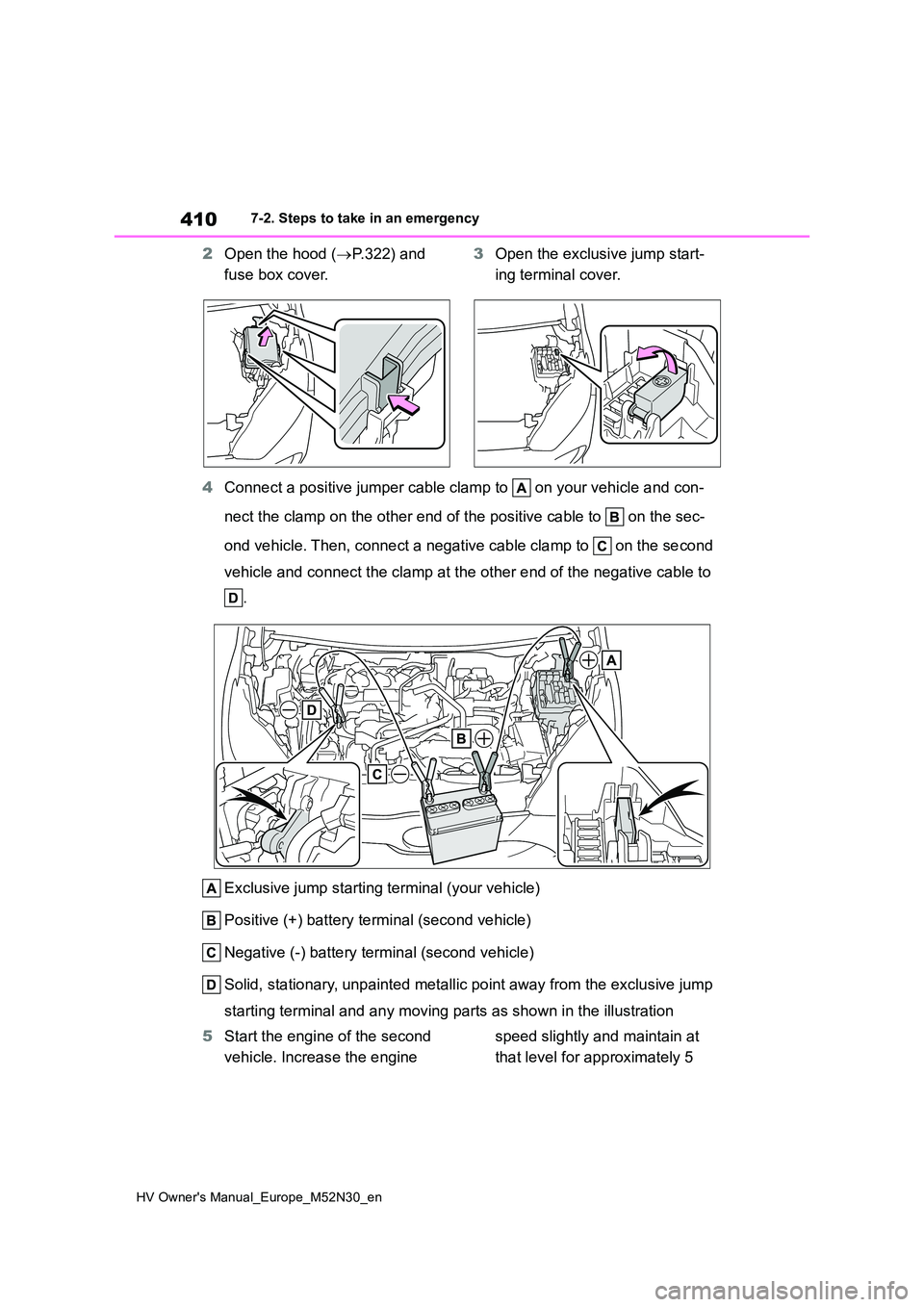
410
HV Owner's Manual_Europe_M52N30_en
7-2. Steps to take in an emergency
2Open the hood (P.322) and
fuse box cover.
3 Open the exclusive jump start-
ing terminal cover.
4 Connect a positive jumper cable clamp to on your vehicle and con-
nect the clamp on the other end of the positive cable to on th e sec-
ond vehicle. Then, connect a negative cable clamp to on the se cond
vehicle and connect the clamp at the other end of the negative cable to
.
Exclusive jump starting terminal (your vehicle)
Positive (+) battery terminal (second vehicle)
Negative (-) battery terminal (second vehicle)
Solid, stationary, unpainted metallic point away from the exclu sive jump
starting terminal and any moving parts as shown in the illustra tion
5 Start the engine of the second
vehicle. Increase the engine
speed slightly and maintain at
that level for approximately 5
Page 413 of 590
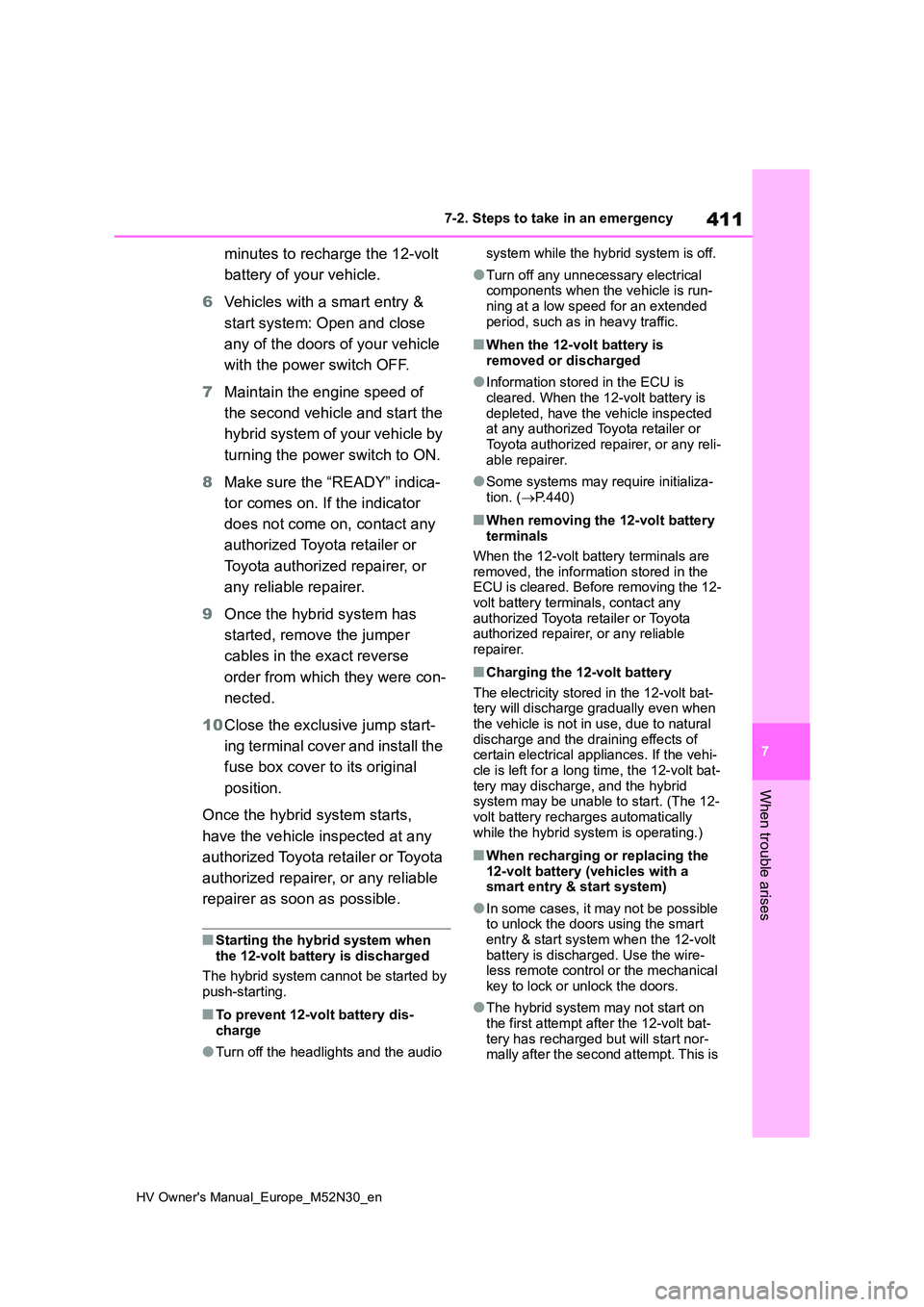
411
7
HV Owner's Manual_Europe_M52N30_en
7-2. Steps to take in an emergency
When trouble arises
minutes to recharge the 12-volt
battery of your vehicle.
6 Vehicles with a smart entry &
start system: Open and close
any of the doors of your vehicle
with the power switch OFF.
7 Maintain the engine speed of
the second vehicle and start the
hybrid system of your vehicle by
turning the power switch to ON.
8 Make sure the “READY” indica-
tor comes on. If the indicator
does not come on, contact any
authorized Toyota retailer or
Toyota authorized repairer, or
any reliable repairer.
9 Once the hybrid system has
started, remove the jumper
cables in the exact reverse
order from which they were con-
nected.
10 Close the exclusive jump start-
ing terminal cover and install the
fuse box cover to its original
position.
Once the hybrid system starts,
have the vehicle inspected at any
authorized Toyota retailer or Toyota
authorized repairer, or any reliable
repairer as soon as possible.
■Starting the hybrid system when the 12-volt battery is discharged
The hybrid system cannot be started by push-starting.
■To prevent 12-volt battery dis-charge
●Turn off the headlights and the audio
system while the hybrid system is off.
●Turn off any unnecessary electrical components when the vehicle is run-
ning at a low speed for an extended period, such as in heavy traffic.
■When the 12-volt battery is removed or discharged
●Information stored in the ECU is cleared. When the 12-volt battery is
depleted, have the vehicle inspected at any authorized Toyota retailer or Toyota authorized repairer, or any reli-
able repairer.
●Some systems may require initializa-
tion. ( P.440)
■When removing the 12-volt battery terminals
When the 12-volt battery terminals are
removed, the information stored in the ECU is cleared. Before removing the 12-volt battery terminals, contact any
authorized Toyota retailer or Toyota authorized repairer, or any reliable repairer.
■Charging the 12-volt battery
The electricity stored in the 12-volt bat- tery will discharge gradually even when the vehicle is not in use, due to natural
discharge and the draining effects of certain electrical appliances. If the vehi-cle is left for a long time, the 12-volt bat-
tery may discharge, and the hybrid system may be unable to start. (The 12-volt battery recharges automatically
while the hybrid system is operating.)
■When recharging or replacing the 12-volt battery (vehicles with a smart entry & start system)
●In some cases, it may not be possible to unlock the doors using the smart
entry & start system when the 12-volt battery is discharged. Use the wire-less remote control or the mechanical
key to lock or unlock the doors.
●The hybrid system may not start on
the first attempt after the 12-volt bat- tery has recharged but will start nor-mally after the second attempt. This is
Page 414 of 590
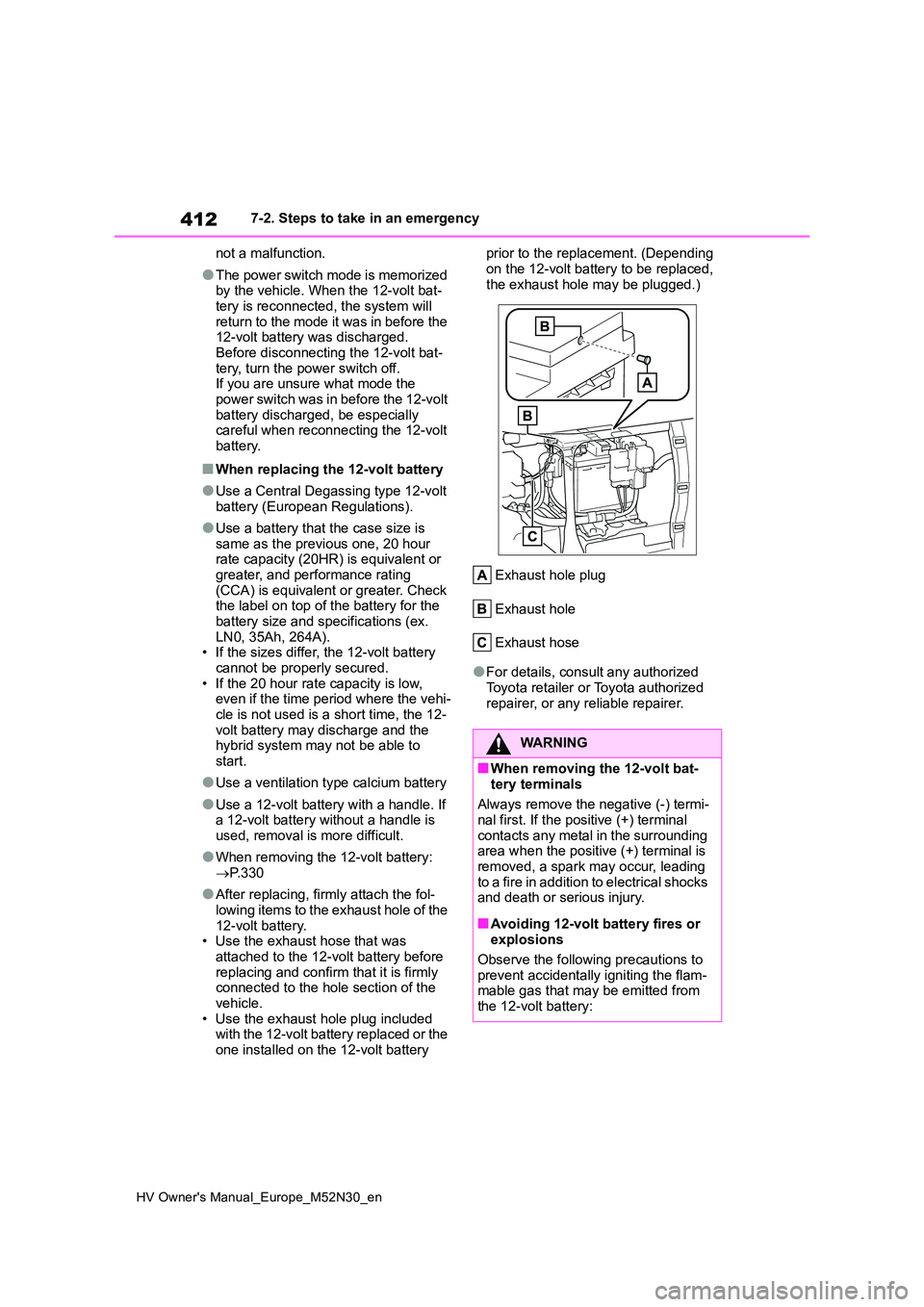
412
HV Owner's Manual_Europe_M52N30_en
7-2. Steps to take in an emergency
not a malfunction.
●The power switch mode is memorized by the vehicle. When the 12-volt bat-
tery is reconnected, the system will return to the mode it was in before the 12-volt battery was discharged.
Before disconnecting the 12-volt bat- tery, turn the power switch off.If you are unsure what mode the
p owe r swi t ch wa s i n be f or e t he 1 2- v ol t battery discharged, be especially careful when reconnecting the 12-volt
battery.
■When replacing the 12-volt battery
●Use a Central Degassing type 12-volt
battery (European Regulations).
●Use a battery that the case size is
same as the previous one, 20 hour rate capacity (20HR) is equivalent or greater, and performance rating
(CCA) is equivalent or greater. Check the label on top of the battery for the battery size and specifications (ex.
LN0, 35Ah, 264A). • If the sizes differ, the 12-volt battery cannot be properly secured.
• If the 20 hour rate capacity is low, even if the time period where the vehi-cle is not used is a short time, the 12-
volt battery may discharge and the hybrid system may not be able to start.
●Use a ventilation type calcium battery
●Use a 12-volt battery with a handle. If a 12-volt battery without a handle is used, removal is more difficult.
●When removing the 12-volt battery: P. 3 3 0
●After replacing, firmly attach the fol- lowing items to the exhaust hole of the
12-volt battery. • Use the exhaust hose that was attached to the 12-volt battery before
replacing and confirm that it is firmly connected to the hole section of the vehicle.
• Use the exhaust hole plug included with the 12-volt battery replaced or the one installed on the 12-volt battery
prior to the replacement. (Depending
on the 12-volt battery to be replaced, the exhaust hole may be plugged.)
Exhaust hole plug
Exhaust hole
Exhaust hose
●For details, consult any authorized Toyota retailer or Toyota authorized
repairer, or any reliable repairer.
WARNING
■When removing the 12-volt bat-
tery terminals
Always remove the negative (-) termi- nal first. If the positive (+) terminal
contacts any metal in the surrounding area when the positive (+) terminal is removed, a spark may occur, leading
to a fire in addition to electrical shocks and death or serious injury.
■Avoiding 12-volt battery fires or explosions
Observe the following precautions to
prevent accidentally igniting the flam- mable gas that may be emitted from the 12-volt battery:
Page 415 of 590
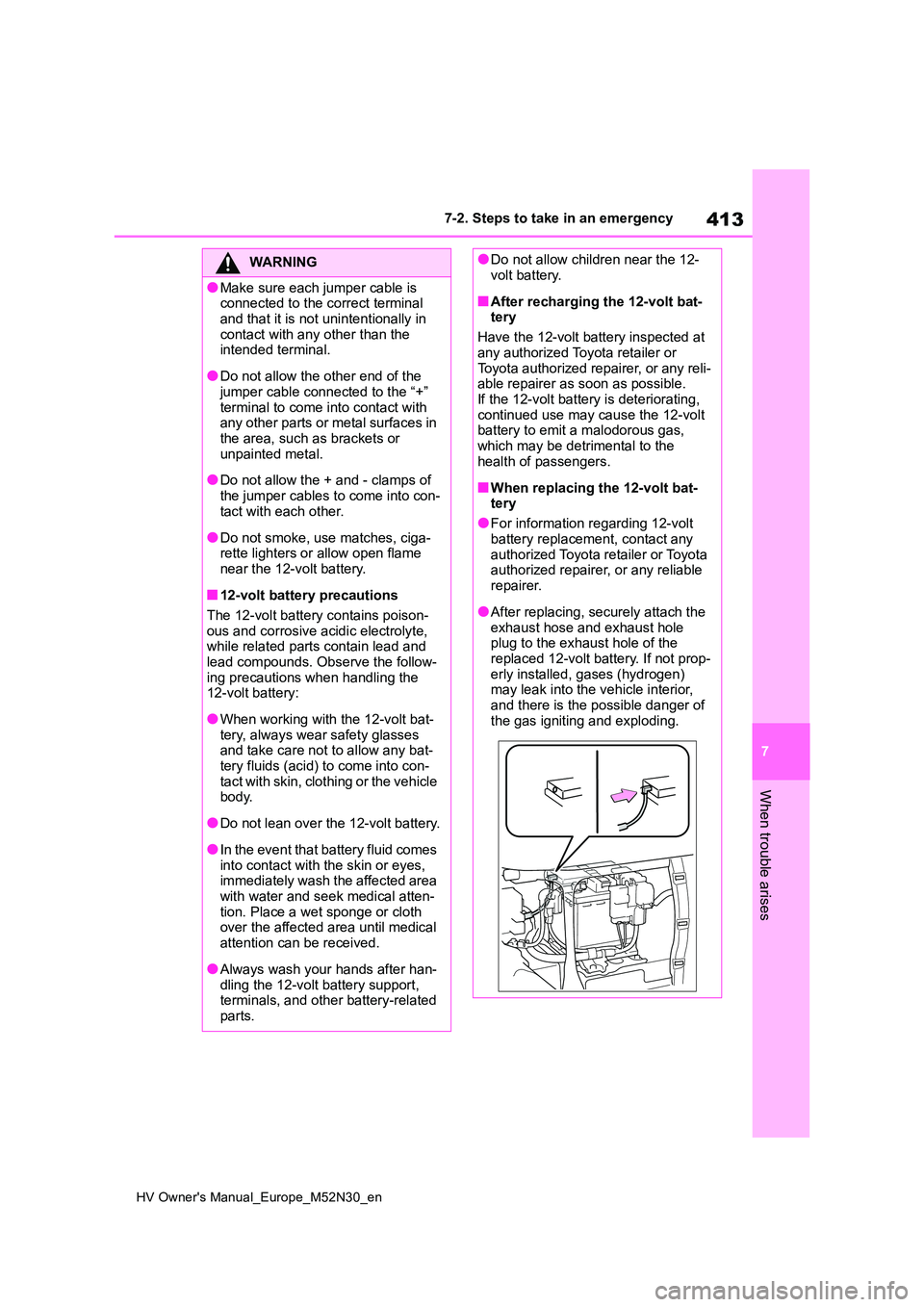
413
7
HV Owner's Manual_Europe_M52N30_en
7-2. Steps to take in an emergency
When trouble arises
WARNING
●Make sure each jumper cable is connected to the correct terminal
and that it is not unintentionally in contact with any other than the intended terminal.
●Do not allow the other end of the jumper cable connected to the “+”
terminal to come into contact with any other parts or metal surfaces in the area, such as brackets or
unpainted metal.
●Do not allow the + and - clamps of
the jumper cables to come into con- tact with each other.
●Do not smoke, use matches, ciga-rette lighters or allow open flame near the 12-volt battery.
■12-volt battery precautions
The 12-volt battery contains poison-
ous and corrosive acidic electrolyte, while related parts contain lead and lead compounds. Observe the follow-
ing precautions when handling the 12-volt battery:
●When working with the 12-volt bat-tery, always wear safety glasses and take care not to allow any bat-
tery fluids (acid) to come into con- tact with skin, clothing or the vehicle body.
●Do not lean over the 12-volt battery.
●In the event that battery fluid comes into contact with the skin or eyes, immediately wash the affected area
with water and seek medical atten- tion. Place a wet sponge or cloth over the affected area until medical
attention can be received.
●Always wash your hands after han-
dling the 12-volt battery support, terminals, and other battery-related parts.
●Do not allow children near the 12-volt battery.
■After recharging the 12-volt bat-tery
Have the 12-volt battery inspected at
any authorized Toyota retailer or Toyota authorized repairer, or any reli-able repairer as soon as possible.
If the 12-volt battery is deteriorating, continued use may cause the 12-volt battery to emit a malodorous gas,
which may be detrimental to the health of passengers.
■When replacing the 12-volt bat-tery
●For information regarding 12-volt
battery replacement, contact any authorized Toyota retailer or Toyota authorized repairer, or any reliable
repairer.
●After replacing, securely attach the
exhaust hose and exhaust hole plug to the exhaust hole of the replaced 12-volt battery. If not prop-
erly installed, gases (hydrogen) may leak into the vehicle interior, and there is the possible danger of
the gas igniting and exploding.
Page 416 of 590
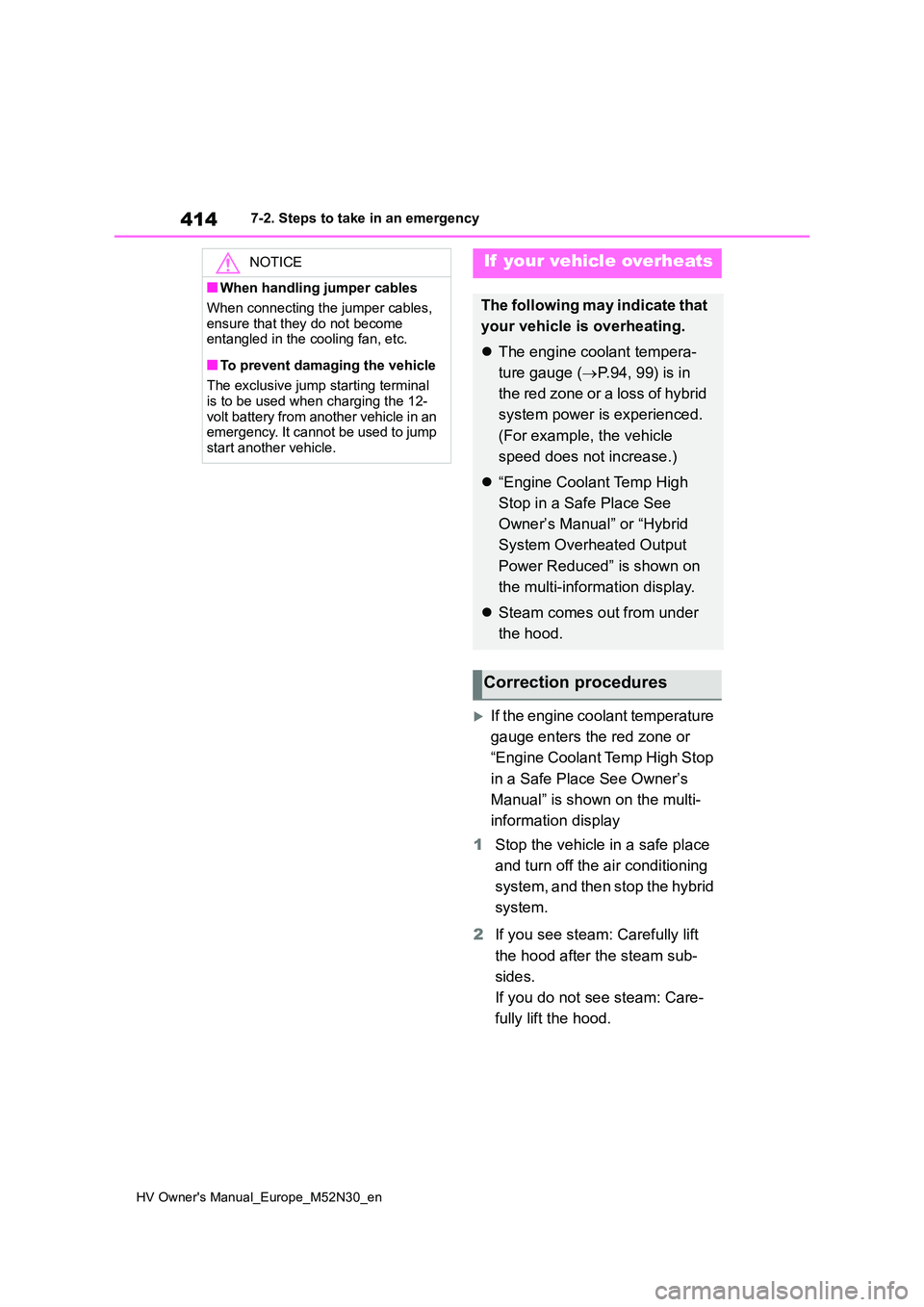
414
HV Owner's Manual_Europe_M52N30_en
7-2. Steps to take in an emergency
If the engine coolant temperature
gauge enters the red zone or
“Engine Coolant Temp High Stop
in a Safe Place See Owner’s
Manual” is shown on the multi-
information display
1 Stop the vehicle in a safe place
and turn off the air conditioning
system, and then stop the hybrid
system.
2 If you see steam: Carefully lift
the hood after the steam sub-
sides.
If you do not see steam: Care-
fully lift the hood.
NOTICE
■When handling jumper cables
When connecting the jumper cables,
ensure that they do not become entangled in the cooling fan, etc.
■To prevent damaging the vehicle
The exclusive jump starting terminal is to be used when charging the 12-
volt battery from another vehicle in an emergency. It cannot be used to jump start another vehicle.
If your vehicle overheats
The following may indicate that
your vehicle is overheating.
The engine coolant tempera-
ture gauge ( P.94, 99) is in
the red zone or a loss of hybrid
system power is experienced.
(For example, the vehicle
speed does not increase.)
“Engine Coolant Temp High
Stop in a Safe Place See
Owner’s Manual” or “Hybrid
System Overheated Output
Power Reduced” is shown on
the multi-information display.
Steam comes out from under
the hood.
Correction procedures
Page 417 of 590
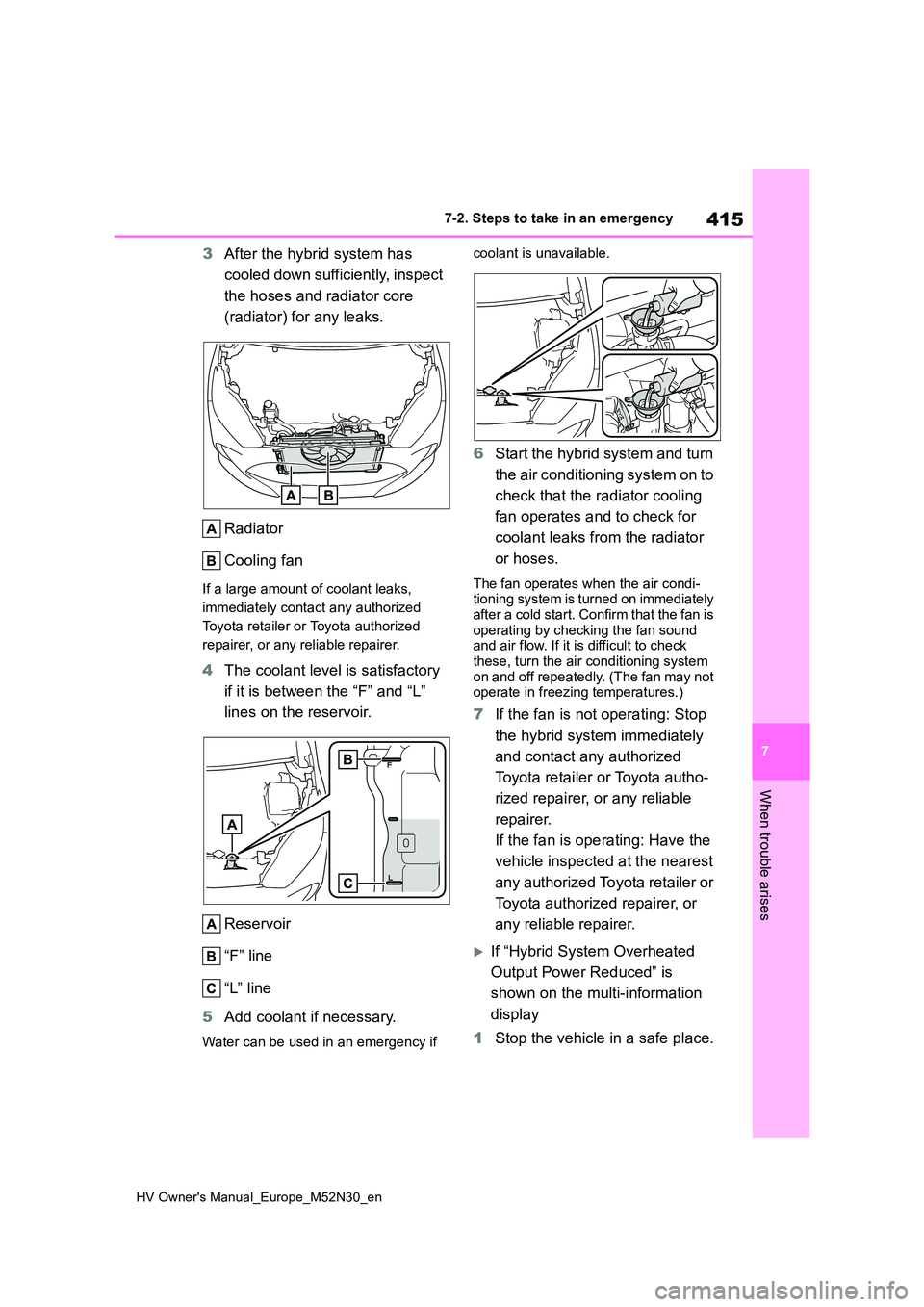
415
7
HV Owner's Manual_Europe_M52N30_en
7-2. Steps to take in an emergency
When trouble arises
3After the hybrid system has
cooled down sufficiently, inspect
the hoses and radiator core
(radiator) for any leaks.
Radiator
Cooling fan
If a large amount of coolant leaks,
immediately contact any authorized
Toyota retailer or Toyota authorized
repairer, or any reliable repairer.
4 The coolant level is satisfactory
if it is between the “F” and “L”
lines on the reservoir.
Reservoir
“F” line
“L” line
5 Add coolant if necessary.
Water can be used in an emergency if
coolant is unavailable.
6 Start the hybrid system and turn
the air conditioning system on to
check that the radiator cooling
fan operates and to check for
coolant leaks from the radiator
or hoses.
The fan operates when the air condi- tioning system is turned on immediately
after a cold start. Confirm that the fan is operating by checking the fan sound and air flow. If it is difficult to check
these, turn the air conditioning system on and off repeatedly. (The fan may not operate in freezing temperatures.)
7 If the fan is not operating: Stop
the hybrid system immediately
and contact any authorized
Toyota retailer or Toyota autho-
rized repairer, or any reliable
repairer.
If the fan is operating: Have the
vehicle inspected at the nearest
any authorized Toyota retailer or
Toyota authorized repairer, or
any reliable repairer.
If “Hybrid System Overheated
Output Power Reduced” is
shown on the multi-information
display
1 Stop the vehicle in a safe place.
Page 418 of 590
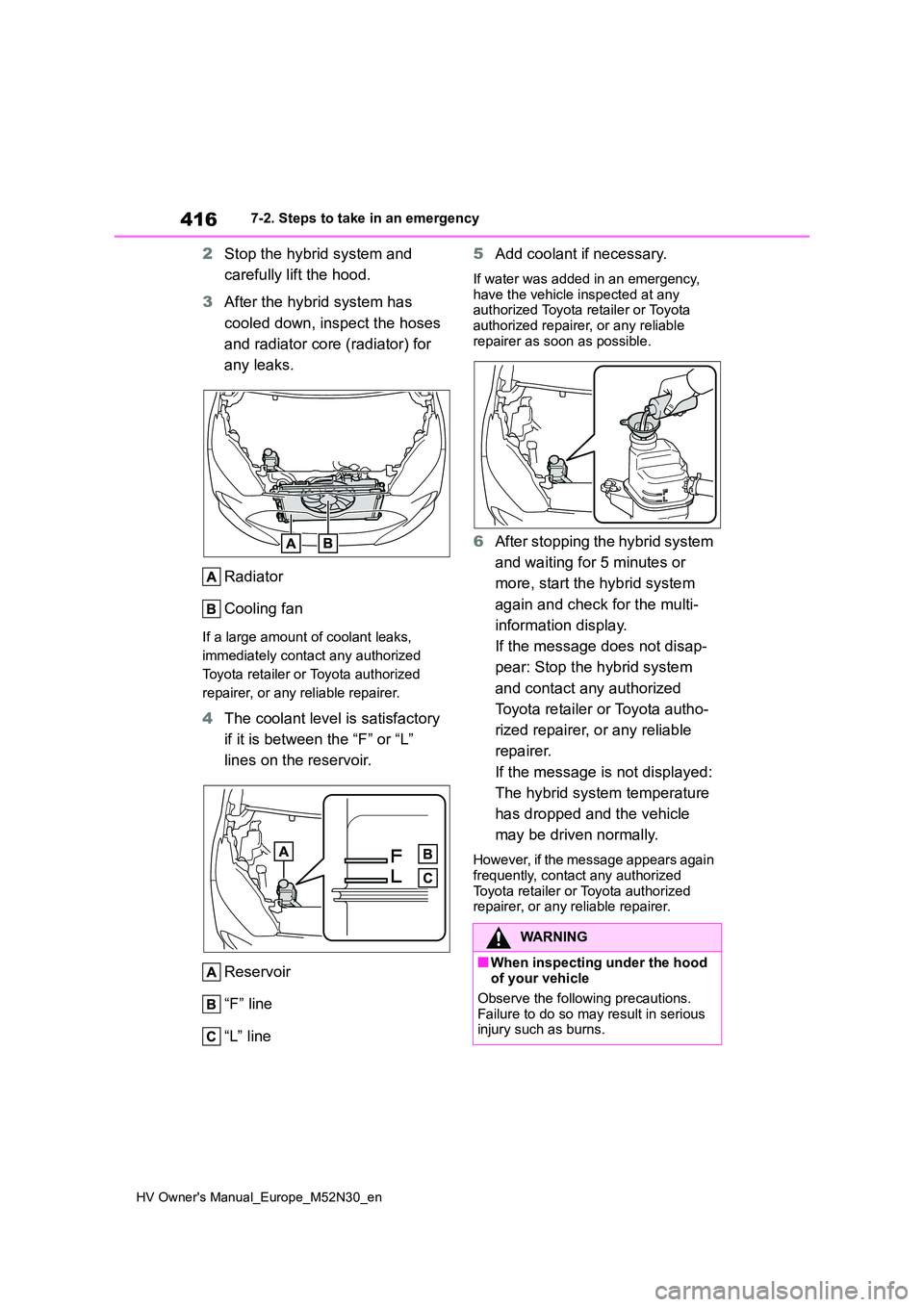
416
HV Owner's Manual_Europe_M52N30_en
7-2. Steps to take in an emergency
2Stop the hybrid system and
carefully lift the hood.
3 After the hybrid system has
cooled down, inspect the hoses
and radiator core (radiator) for
any leaks.
Radiator
Cooling fan
If a large amount of coolant leaks,
immediately contact any authorized
Toyota retailer or Toyota authorized
repairer, or any reliable repairer.
4 The coolant level is satisfactory
if it is between the “F” or “L”
lines on the reservoir.
Reservoir
“F” line
“L” line
5 Add coolant if necessary.
If water was added in an emergency, have the vehicle inspected at any authorized Toyota retailer or Toyota
authorized repairer, or any reliable repairer as soon as possible.
6 After stopping the hybrid system
and waiting for 5 minutes or
more, start the hybrid system
again and check for the multi-
information display.
If the message does not disap-
pear: Stop the hybrid system
and contact any authorized
Toyota retailer or Toyota autho-
rized repairer, or any reliable
repairer.
If the message is not displayed:
The hybrid system temperature
has dropped and the vehicle
may be driven normally.
However, if the message appears again
frequently, contact any authorized Toyota retailer or Toyota authorized repairer, or any reliable repairer.
WARNING
■When inspecting under the hood of your vehicle
Observe the following precautions.
Failure to do so may result in serious injury such as burns.
Page 419 of 590
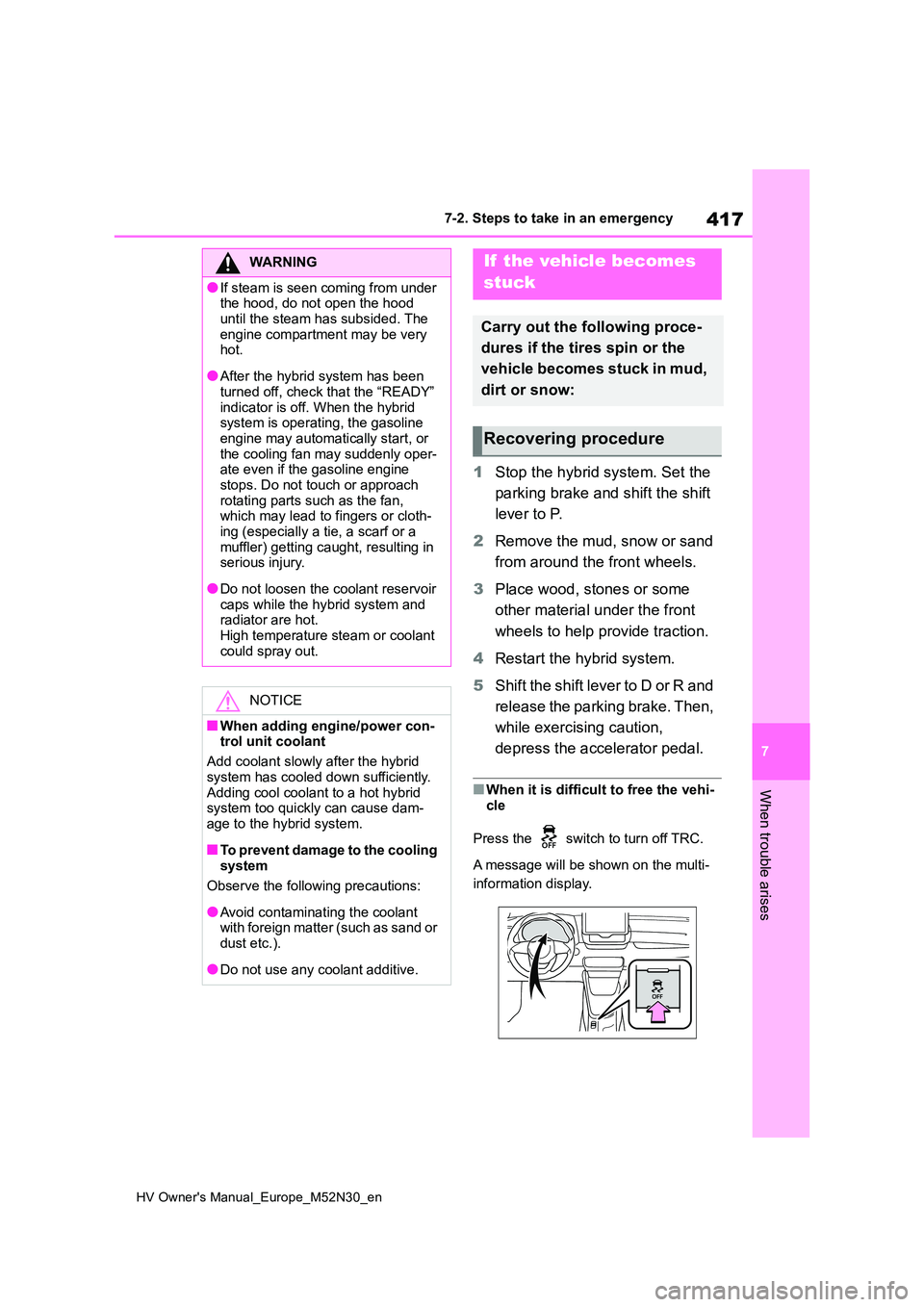
417
7
HV Owner's Manual_Europe_M52N30_en
7-2. Steps to take in an emergency
When trouble arises
1Stop the hybrid system. Set the
parking brake and shift the shift
lever to P.
2 Remove the mud, snow or sand
from around the front wheels.
3 Place wood, stones or some
other material under the front
wheels to help provide traction.
4 Restart the hybrid system.
5 Shift the shift lever to D or R and
release the parking brake. Then,
while exercising caution,
depress the accelerator pedal.
■When it is difficult to free the vehi-
cle
Press the switch to turn off TRC.
A message will be shown on the multi-
information display.
WARNING
●If steam is seen coming from under the hood, do not open the hood
until the steam has subsided. The engine compartment may be very hot.
●After the hybrid system has been turned off, check that the “READY”
indicator is off. When the hybrid system is operating, the gasoline engine may automatically start, or
the cooling fan may suddenly oper- ate even if the gasoline engine stops. Do not touch or approach
rotating parts such as the fan, which may lead to fingers or cloth-ing (especially a tie, a scarf or a
muffler) getting caught, resulting in serious injury.
●Do not loosen the coolant reservoir caps while the hybrid system and radiator are hot.
High temperature steam or coolant could spray out.
NOTICE
■When adding engine/power con-trol unit coolant
Add coolant slowly after the hybrid
system has cooled down sufficiently. Adding cool coolant to a hot hybrid system too quickly can cause dam-
age to the hybrid system.
■To prevent damage to the cooling
system
Observe the following precautions:
●Avoid contaminating the coolant with foreign matter (such as sand or dust etc.).
●Do not use any coolant additive.
If the vehicle becomes
stuck
Carry out the following proce-
dures if the tires spin or the
vehicle becomes stuck in mud,
dirt or snow:
Recovering procedure
Page 420 of 590
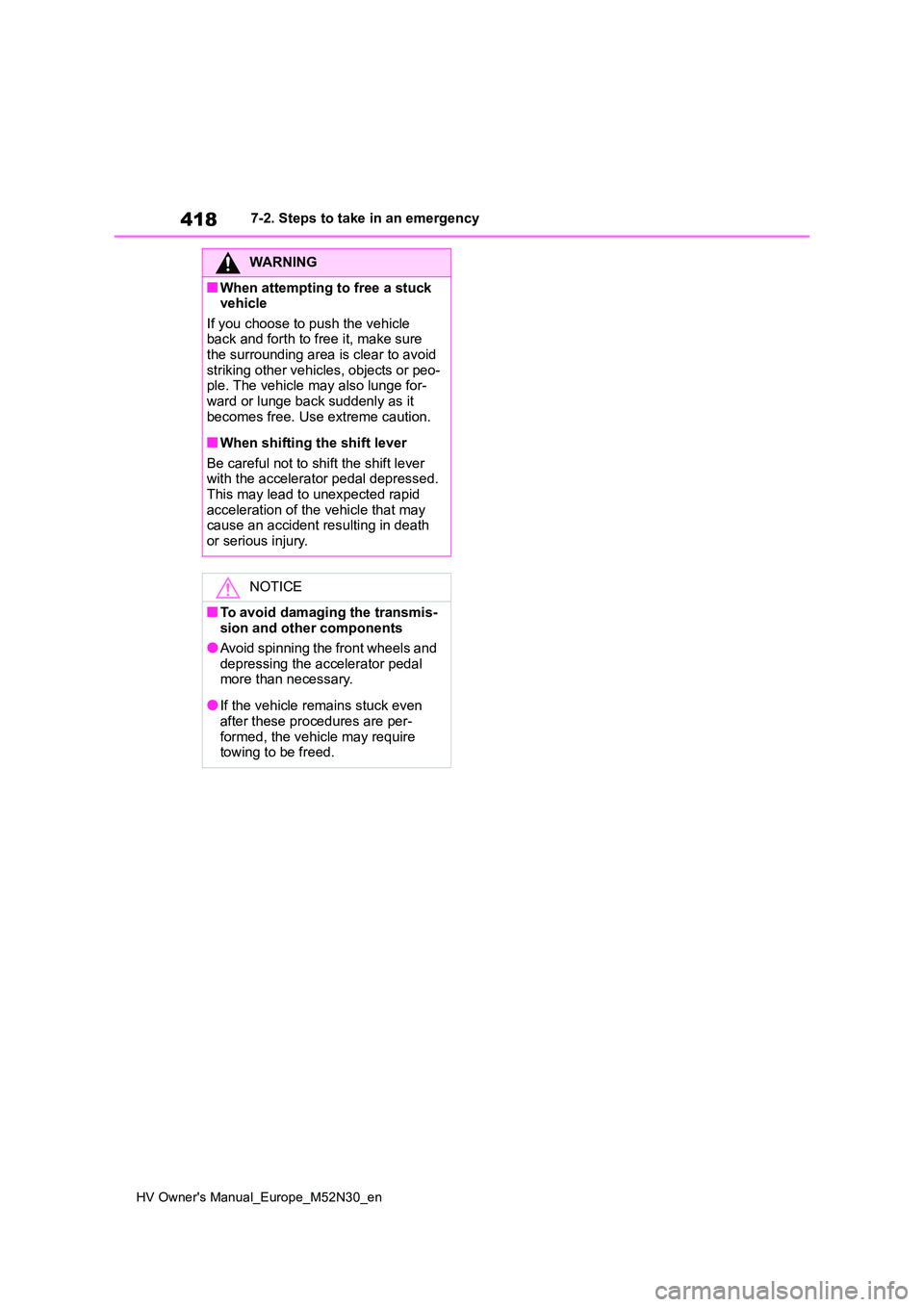
418
HV Owner's Manual_Europe_M52N30_en
7-2. Steps to take in an emergency
WARNING
■When attempting to free a stuck vehicle
If you choose to push the vehicle back and forth to free it, make sure the surrounding area is clear to avoid
striking other vehicles, objects or peo- ple. The vehicle may also lunge for-ward or lunge back suddenly as it
becomes free. Use extreme caution.
■When shifting the shift lever
Be careful not to shift the shift lever with the accelerator pedal depressed.This may lead to unexpected rapid
acceleration of the vehicle that may cause an accident resulting in death or serious injury.
NOTICE
■To avoid damaging the transmis-sion and other components
●Avoid spinning the front wheels and depressing the accelerator pedal more than necessary.
●If the vehicle remains stuck even
after these procedures are per- formed, the vehicle may require towing to be freed.